Packaging and Sustainable Development
- 格式:doc
- 大小:29.00 KB
- 文档页数:2
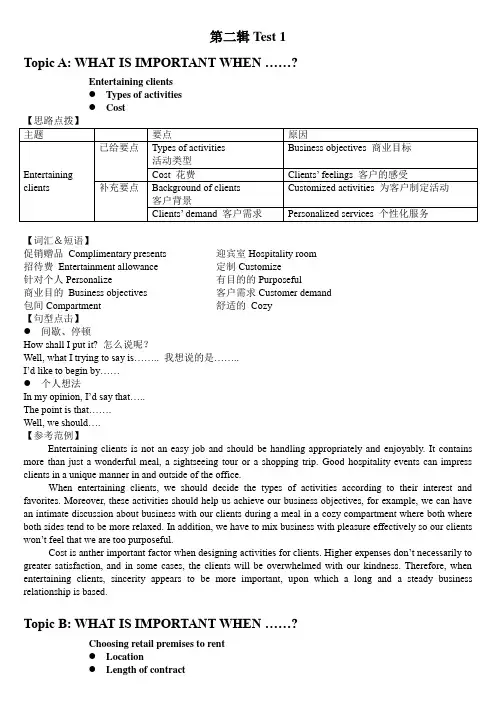
第二辑Test 1Topic A: WHAT IS IMPORTANT WHEN ……?Entertaining clients●Types of activities●Cost【词汇&短语】促销赠品Complimentary presents 迎宾室Hospitality room招待费Entertainment allowance 定制Customize针对个人Personalize 有目的的Purposeful商业目的Business objectives 客户需求Customer demand包间Compartment 舒适的Cozy【句型点击】●间歇、停顿How shall I put it? 怎么说呢?Well, what I trying to say is…….. 我想说的是……..I’d like to begin by……●个人想法In my opinion, I’d say that…..The point is that…….Well, we should….【参考范例】Entertaining clients is not an easy job and should be handling appropriately and enjoyably. It contains more than just a wonderful meal, a sightseeing tour or a shopping trip. Good hospitality events can impress clients in a unique manner in and outside of the office.When entertaining clients, we should decide the types of activities according to their interest and favorites. Moreover, these activities should help us achieve our business objectives, for example, we can have an intimate discussion about business with our clients during a meal in a cozy compartment where both where both sides tend to be more relaxed. In addition, we have to mix business with pleasure effectively so our clients won’t feel that we are too purposeful.Cost is anther importan t factor when designing activities for clients. Higher expenses don’t necessarily to greater satisfaction, and in some cases, the clients will be overwhelmed with our kindness. Therefore, when entertaining clients, sincerity appears to be more important, upon which a long and a steady business relationship is based.Topic B: WHAT IS IMPORTANT WHEN ……?Choosing retail premises to rent●Location●Length of contract【思路点拨】【词汇&短语】房东landlord 利润空间profit margin租户tenant 房屋结构building structure可持续发展sustainable development 合同到期exploration of contract繁荣boom prosperity 续签合同renew the contract租金rent 押金deposit【句型点击】●观点阐述Well, it seems to me that…….T hat’s true, but on the other hand…..●追加观点That’s just what/all I was thinking…..Well, the point I’m trying to make it that……Another thing I want to mention is……【参考范例】When aiming to choose retail premises, you should always put the location on the top of your list. An ideal retail premises should be situated in the downtown district or a big residential area where the sources of the customers is guaranteed, in China, A lot of businessman believe in Fengshui and they think a good location is vital to the success of business.Besides, the length of contract is also an important factor in choosing retail premises because the retailer need time to develop market and customers. A steady and uninterrupted business environment is most desired, and a long-term contract will ensure the retailer’s sustainable development.What’s more, rent and means of payment should never be overlooked, retailers in general have a big cash flow, therefore, a reasonable rent and flexible means of payment are good for their capital turnover. A cooperative landlord is preferred and necessary for a win-win situation.Topic C: WHAT IS IMPORTANT WHEN ……?Deciding on packaging for products●Image●Production process【思路点拨】【词汇&短语】包装材料wrapper,packaging material 不可再生资源non-renewable resources包装设计package design 有利环境的environmental-friendly顾客的青睐customer favor 肤浅的,表明的superficial【句型点击】●自然过渡How shall I put it? 怎么说呢?Actually…..That’s just how I see it …..●个人观点Personally, I thi nk…..Frankly, I think….【参考范例】Packing of products concerns the fate of products because it arouses people’s desire for purchase. When deciding on packaging for products, we should take several things into consideration.First of all, the image catches the eye of potential customers, people are sometimes skin deep when surrounded by a variety of products, their decisions are simply based upon the packaging, therefore a thoughtful design in color, shape and packaging materials is crucial in winn ing customer’s favor.On the other hand, the cost of packaging should be carefully dealt with because it is contained in the prices of the products. Increased price will make the products less competitive in a buyer’s market. After all, in comparison with packaging, people are more sensitive to price.Last but not least, our resources are limited and some are even non-renewable. Once the products are opened up, the wrapper are useless, so it is expected that designers can develop further uses of packaging materials or at least make them environmental-friendly.第二辑Test 2Topic A: WHAT IS IMPORTANT WHEN ……?Selecting staff for promotion●Attitude to work●Current performance【词汇&短语】空缺职位vacancy 人事部personnel行政管理部administration 公关public relations总部head office 工资wages and salaries管理技能managerial skill 职业前景career prospect人力资源部human resources 团队协作teamwork【句型点击】●常用开始语Thank you for your questionThe answer is…Let me start with….In my viewIt is very likely that….●表达观点常用句What I am thinking is….Let me make my point very clear.It is crystal clear that…..There is no doubt that…..I am into the first opinion..【句型点击】When selecting staff for promotion, several factors should be taken into consideration, to begin with, the attitude to the work is one of the most fundamental elements. I believe attitude is everything. It is not uncommon to find workers who have great talents but are reluctant to make full contribution in their position, the point is, you have to love what you are doing and you have to try your utmost and reserve no effort to do it.Secondly, current performance is also very important, because it is obvious that attitude and effort have to be measured in a certain way so that you can know everyone’s capability.Thirdly, you can’t ignore career potential and adaptability, almost in every company, we can find employees who are excellent individuals but fail to cooperate in a team, these elements are all very essential in one’s career. Admittedly, it is not very likely to find all of them in one person, and then you have to consider about the specific position and grant priority to one of them.Topic B: WHAT IS I MPORTANT WHEN ……?Considering a career change●Further study or training●Opportunities for future promotion【词汇&短语】实际工资real wages 合并merger最终目标ultimate goal 个人收入personal income坏的影响adverse effect 工资价格螺旋上升wage-price spiral精明的讨价还价交易horse-trading 无形资产intangible assets资格qualification 投资回报return on investment【句型点击】●更倾向于某一个选项I would take …….. as my priority 我会把……..作为我的首选项。
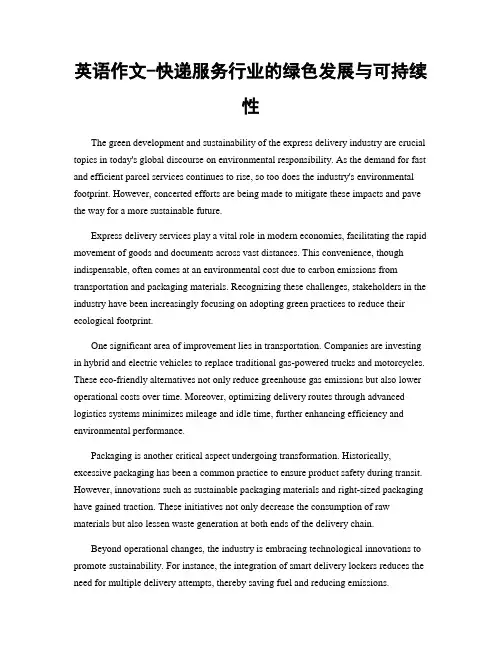
英语作文-快递服务行业的绿色发展与可持续性The green development and sustainability of the express delivery industry are crucial topics in today's global discourse on environmental responsibility. As the demand for fast and efficient parcel services continues to rise, so too does the industry's environmental footprint. However, concerted efforts are being made to mitigate these impacts and pave the way for a more sustainable future.Express delivery services play a vital role in modern economies, facilitating the rapid movement of goods and documents across vast distances. This convenience, though indispensable, often comes at an environmental cost due to carbon emissions from transportation and packaging materials. Recognizing these challenges, stakeholders in the industry have been increasingly focusing on adopting green practices to reduce their ecological footprint.One significant area of improvement lies in transportation. Companies are investing in hybrid and electric vehicles to replace traditional gas-powered trucks and motorcycles. These eco-friendly alternatives not only reduce greenhouse gas emissions but also lower operational costs over time. Moreover, optimizing delivery routes through advanced logistics systems minimizes mileage and idle time, further enhancing efficiency and environmental performance.Packaging is another critical aspect undergoing transformation. Historically, excessive packaging has been a common practice to ensure product safety during transit. However, innovations such as sustainable packaging materials and right-sized packaging have gained traction. These initiatives not only decrease the consumption of raw materials but also lessen waste generation at both ends of the delivery chain.Beyond operational changes, the industry is embracing technological innovations to promote sustainability. For instance, the integration of smart delivery lockers reduces the need for multiple delivery attempts, thereby saving fuel and reducing emissions.Additionally, digital solutions like route optimization algorithms and real-time tracking systems enhance operational efficiency while minimizing environmental impact.Collaboration across the supply chain is pivotal in achieving sustainable outcomes. Partnerships between delivery companies, e-commerce platforms, and customers can foster the adoption of environmentally responsible practices. Educating consumers about the environmental impact of delivery choices encourages them to opt for consolidated shipments or slower delivery options, which are typically more eco-friendly.Government regulations and incentives also play a crucial role in shaping the industry's sustainability efforts. Policies that promote the use of electric vehicles, offer tax incentives for green investments, or impose carbon pricing mechanisms incentivize businesses to prioritize sustainability in their operations. Such regulatory frameworks provide a level playing field and encourage industry-wide compliance with environmental standards.Furthermore, transparency and accountability are essential for measuring progress towards sustainability goals. Many companies now publish annual sustainability reports detailing their environmental initiatives, carbon emissions, and waste reduction efforts. This transparency not only builds trust with stakeholders but also encourages continuous improvement and innovation within the industry.Looking ahead, the express delivery industry faces the dual challenge of meeting growing consumer expectations for speed and convenience while minimizing its environmental impact. By embracing green technologies, optimizing logistics, reducing packaging waste, and fostering collaboration, the industry can achieve a balance between economic growth and environmental stewardship. This proactive approach not only benefits the planet but also enhances operational efficiency and strengthens market competitiveness in an increasingly environmentally conscious world.。
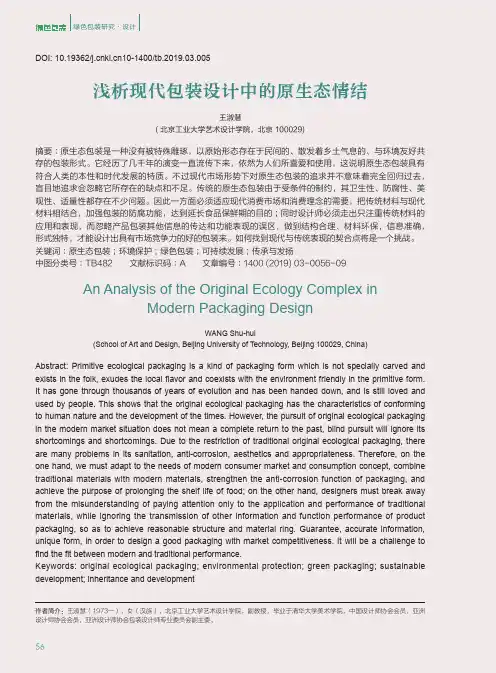
Abstract: Primitive ecological packaging is a kind of packaging form which is not specially carved and exists in the folk, exudes the local flavor and coexists with the environment friendly in the primitive form. It has gone through thousands of years of evolution and has been handed down, and is still loved and used by people. This shows that the original ecological packaging has the characteristics of conforming to human nature and the development of the times. However, the pursuit of original ecological packaging in the modern market situation does not mean a complete return to the past, blind pursuit will ignore its shortcomings and shortcomings. Due to the restriction of traditional original ecological packaging, there are many problems in its sanitation, anti-corrosion, aesthetics and appropriateness. Therefore, on the one hand, we must adapt to the needs of modern consumer market and consumption concept, combine traditional materials with modern materials, strengthen the anti-corrosion function of packaging, and achieve the purpose of prolonging the shelf life of food; on the other hand, designers must break away from the misunderstanding of paying attention only to the application and performance of traditional materials, while ignoring the transmission of other information and function performance of product packaging, so as to achieve reasonable structure and material ring. Guarantee, accurate information, unique form, in order to design a good packaging with market competitiveness. It will be a challenge to find the fit between modern and traditional performance.Keywords: original ecological packaging; environmental protection; green packaging; sustainable development; inheritance and development王淑慧(北京工业大学艺术设计学院,北京 100029)浅析现代包装设计中的原生态情结An Analysis of the Original Ecology Complex inModern Packaging DesignWANG Shu-hui(School of Art and Design, Beijing University of Technology, Beijing 100029, China)摘要:原生态包装是一种没有被特殊雕琢,以原始形态存在于民间的、散发着乡土气息的、与环境友好共存的包装形式。
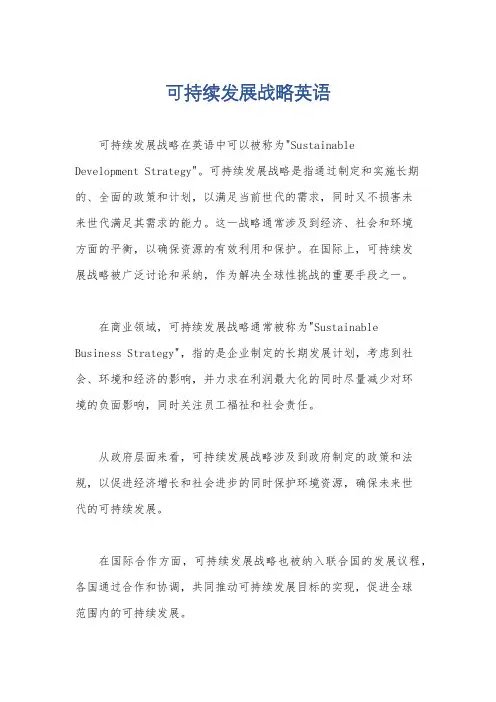
可持续发展战略英语
可持续发展战略在英语中可以被称为"Sustainable Development Strategy"。
可持续发展战略是指通过制定和实施长期的、全面的政策和计划,以满足当前世代的需求,同时又不损害未
来世代满足其需求的能力。
这一战略通常涉及到经济、社会和环境
方面的平衡,以确保资源的有效利用和保护。
在国际上,可持续发
展战略被广泛讨论和采纳,作为解决全球性挑战的重要手段之一。
在商业领域,可持续发展战略通常被称为"Sustainable Business Strategy",指的是企业制定的长期发展计划,考虑到社会、环境和经济的影响,并力求在利润最大化的同时尽量减少对环
境的负面影响,同时关注员工福祉和社会责任。
从政府层面来看,可持续发展战略涉及到政府制定的政策和法规,以促进经济增长和社会进步的同时保护环境资源,确保未来世
代的可持续发展。
在国际合作方面,可持续发展战略也被纳入联合国的发展议程,各国通过合作和协调,共同推动可持续发展目标的实现,促进全球
范围内的可持续发展。
总的来说,可持续发展战略在不同层面都扮演着重要的角色,是为了实现经济、社会和环境的协调发展,以应对全球性挑战和问题。

对商品过度包装的看法和建议英语作文Excessive Packaging of Goods: Concerns and RecommendationsIn recent years, the issue of excessive packaging of consumer goods has become a growing concern for both consumers and environmentalists. As an artificialintelligence system, I have observed this trend and have some thoughts to share on the matter.One of the primary issues with excessive packaging isthe significant environmental impact it has. The production, transportation, and disposal of packaging materials, suchas plastic, cardboard, and Styrofoam, contribute to the depletion of natural resources, increased greenhouse gas emissions, and the accumulation of waste in landfills and oceans. This not only harms the environment but also has long-term consequences for the health and well-being of our planet and its inhabitants.Moreover, excessive packaging often adds unnecessarycosts to the products, which are ultimately passed on tothe consumers. This can be particularly problematic forlow-income individuals and families, who may have to allocate a larger portion of their budget to cover these additional expenses. Additionally, the excessive use of packaging materials can lead to higher transportation costs and fuel consumption, further contributing to the overall environmental impact.Another concern with excessive packaging is thepotential for it to mislead consumers. In some cases, the packaging may be designed to make the product appear larger or more substantial than it actually is, leading to a disconnect between the perceived and actual value of the item. This can erode consumer trust and contribute to a sense of dissatisfaction with the purchasing experience.To address these issues, there are several recommendations that can be considered:1. Encourage the development and implementation of more sustainable packaging solutions: Governments, businesses, and consumers should work together to promote the use of eco-friendly materials, such as biodegradable, recyclable, or compostable packaging. This could involve implementing policies that incentivize the use of sustainable packaging,as well as investing in research and development to create innovative packaging alternatives.2. Implement stricter regulations and guidelines on packaging: Policymakers should consider enacting regulations that limit the amount of packaging allowed for certain products, or that require manufacturers to use a minimum percentage of recycled or renewable materials in their packaging. This could help to reduce the overall environmental impact of packaging waste.3. Educate consumers on the importance of reducing packaging waste: Campaigns and educational programs can be developed to raise awareness among consumers about the environmental and economic consequences of excessive packaging. This can empower individuals to make more informed purchasing decisions and to advocate for change within the marketplace.4. Encourage businesses to adopt more sustainable packaging practices: Companies should be incentivized to minimize the use of packaging, optimize the design of their packaging, and explore alternative delivery methods that reduce the need for packaging altogether. This couldinvolve the use of refillable containers, the implementation of take-back programs, or the development of innovative product distribution models.5. Support the development of a circular economy: By promoting the reuse, recycling, and repurposing of packaging materials, we can move towards a more sustainable and circular economic model that reduces waste and promotes the efficient use of resources.综上所述,过度包装不仅给环境带来负面影响,也增加了消费者的成本负担,并可能导致消费者的信任度下降。
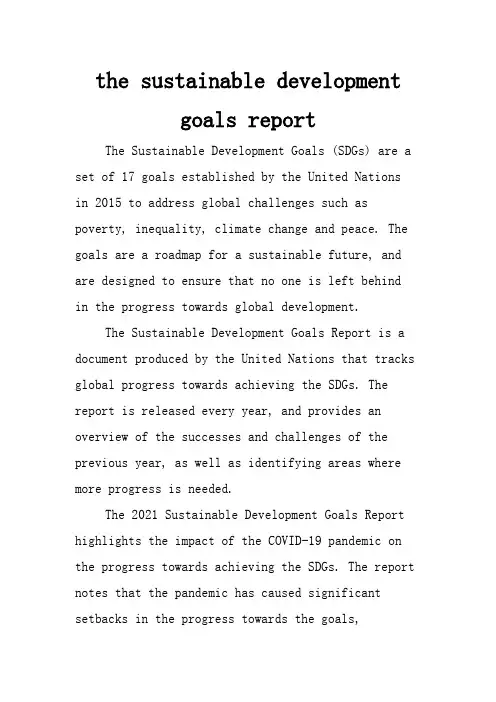
the sustainable developmentgoals reportThe Sustainable Development Goals (SDGs) are a set of 17 goals established by the United Nationsin 2015 to address global challenges such as poverty, inequality, climate change and peace. The goals are a roadmap for a sustainable future, and are designed to ensure that no one is left behindin the progress towards global development.The Sustainable Development Goals Report is a document produced by the United Nations that tracks global progress towards achieving the SDGs. The report is released every year, and provides an overview of the successes and challenges of the previous year, as well as identifying areas where more progress is needed.The 2021 Sustainable Development Goals Report highlights the impact of the COVID-19 pandemic on the progress towards achieving the SDGs. The report notes that the pandemic has caused significant setbacks in the progress towards the goals,particularly in areas such as poverty, education, and health. The report states that the pandemic has pushed an additional 120 million people into extreme poverty, and has disrupted education for over 1.6 billion students worldwide.Despite these setbacks, the report also highlights areas of progress. The report notes that significant progress has been made towards reducing maternal and child mortality rates, and that the number of people without access to electricity has continued to decline. The report also notes that progress has been made towards reducing greenhouse gas emissions, although more action is needed to meet global climate targets.The report also highlights the importance of partnerships in achieving the SDGs. The report notes that progress towards the SDGs can only be achieved through collaborative action across all sectors and stakeholders, including governments, civil society, and the private sector. The report calls for increased investment in sustainabledevelopment and for the establishment of effective partnerships to achieve the SDGs.The Sustainable Development Goals Report is an important document that provides an overview of global progress towards achieving the SDGs. The report highlights the successes and challenges of the previous year, and identifies areas where more progress is needed. The report also emphasizes the importance of partnerships in achieving the SDGs, and calls for increased investment in sustainable development. The SDGs are a roadmap for a sustainable future, and the Sustainable Development Goals Report plays a critical role in tracking progress towards this goal.。
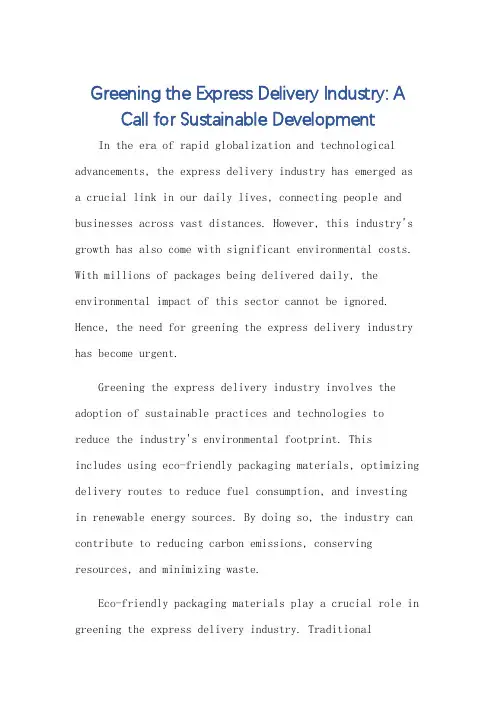
Greening the Express Delivery Industry: A Call for Sustainable DevelopmentIn the era of rapid globalization and technological advancements, the express delivery industry has emerged as a crucial link in our daily lives, connecting people and businesses across vast distances. However, this industry's growth has also come with significant environmental costs. With millions of packages being delivered daily, the environmental impact of this sector cannot be ignored. Hence, the need for greening the express delivery industry has become urgent.Greening the express delivery industry involves the adoption of sustainable practices and technologies to reduce the industry's environmental footprint. This includes using eco-friendly packaging materials, optimizing delivery routes to reduce fuel consumption, and investingin renewable energy sources. By doing so, the industry can contribute to reducing carbon emissions, conserving resources, and minimizing waste.Eco-friendly packaging materials play a crucial role in greening the express delivery industry. Traditionalpackaging materials such as plastic bags and Styrofoamboxes are not only non-biodegradable but also contribute to significant waste. Transitioning to sustainable packaging options like reusable bags, cardboard boxes, and compostable materials can help reduce waste and promote recycling. Additionally, using bio-based inks and adhesives for labeling and sealing can further reduce the environmental impact of packaging.Optimizing delivery routes is another key aspect of greening the express delivery industry. By using advanced technology like GPS tracking and route optimization software, delivery companies can plan more efficient routes, reducing fuel consumption and emissions. This not onlyhelps the environment but can also lead to cost savings for the companies.Investing in renewable energy sources is anothercritical step towards greening the express delivery industry. Transitioning to clean energy like solar and wind power can help reduce the industry's reliance on fossil fuels, further reducing carbon emissions. This also sends astrong message to the market and society that the industryis committed to sustainable development.In addition to these measures, the express delivery industry can also promote green practices among its customers. Encouraging customers to reuse packaging materials, consolidate their shipments, and opt fordelivery options that minimize environmental impact canhelp create a more sustainable delivery ecosystem.In conclusion, greening the express delivery industryis crucial for sustainable development. By adopting sustainable practices and technologies, the industry can reduce its environmental footprint, contribute to global efforts in climate change mitigation, and create a more sustainable future for all. It is a call for all stakeholders in the industry, including delivery companies, customers, and policymakers, to work towards making this vision a reality.**快递绿色英语作文:推动快递行业可持续发展**在全球化和科技飞速发展的时代,快递行业已经成为我们日常生活中不可或缺的一环,连接着世界各地的个人和企业。
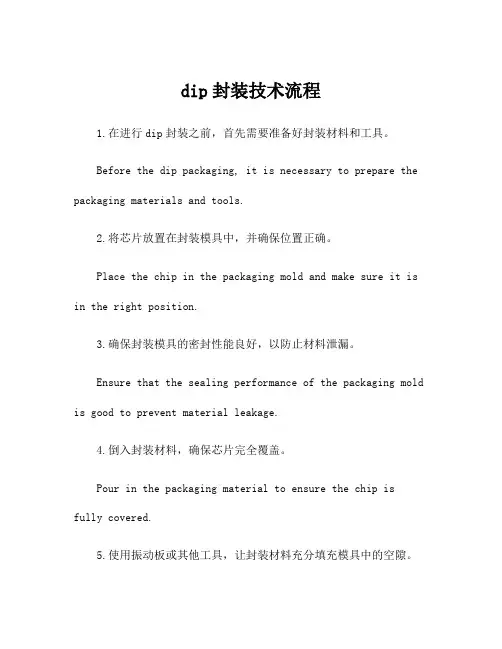
dip封装技术流程1.在进行dip封装之前,首先需要准备好封装材料和工具。
Before the dip packaging, it is necessary to prepare the packaging materials and tools.2.将芯片放置在封装模具中,并确保位置正确。
Place the chip in the packaging mold and make sure it is in the right position.3.确保封装模具的密封性能良好,以防止材料泄漏。
Ensure that the sealing performance of the packaging mold is good to prevent material leakage.4.倒入封装材料,确保芯片完全覆盖。
Pour in the packaging material to ensure the chip isfully covered.5.使用振动板或其他工具,让封装材料充分填充模具中的空隙。
Use a vibrating plate or other tools to make the packaging material fully fill the gaps in the mold.6.用刮刀将多余的封装材料刮平,以确保封装表面平整。
Use a scraper to flatten the excess packaging material to ensure a smooth packaging surface.7.等待封装材料固化,确保芯片不会在封装过程中移位。
Wait for the packaging material to solidify to ensurethat the chip does not shift during the packaging process.8.检查封装后的芯片是否有漏封的情况,及时进行修补。
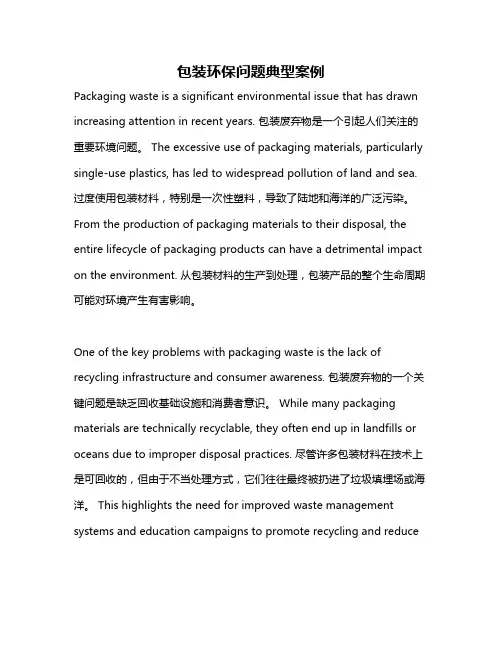
包装环保问题典型案例Packaging waste is a significant environmental issue that has drawn increasing attention in recent years. 包装废弃物是一个引起人们关注的重要环境问题。
The excessive use of packaging materials, particularly single-use plastics, has led to widespread pollution of land and sea. 过度使用包装材料,特别是一次性塑料,导致了陆地和海洋的广泛污染。
From the production of packaging materials to their disposal, the entire lifecycle of packaging products can have a detrimental impact on the environment. 从包装材料的生产到处理,包装产品的整个生命周期可能对环境产生有害影响。
One of the key problems with packaging waste is the lack of recycling infrastructure and consumer awareness. 包装废弃物的一个关键问题是缺乏回收基础设施和消费者意识。
While many packaging materials are technically recyclable, they often end up in landfills or oceans due to improper disposal practices. 尽管许多包装材料在技术上是可回收的,但由于不当处理方式,它们往往最终被扔进了垃圾填埋场或海洋。
This highlights the need for improved waste management systems and education campaigns to promote recycling and reducepackaging waste. 这突显了改善废物处理系统和开展教育宣传活动,以促进回收和减少包装废弃物的必要性。
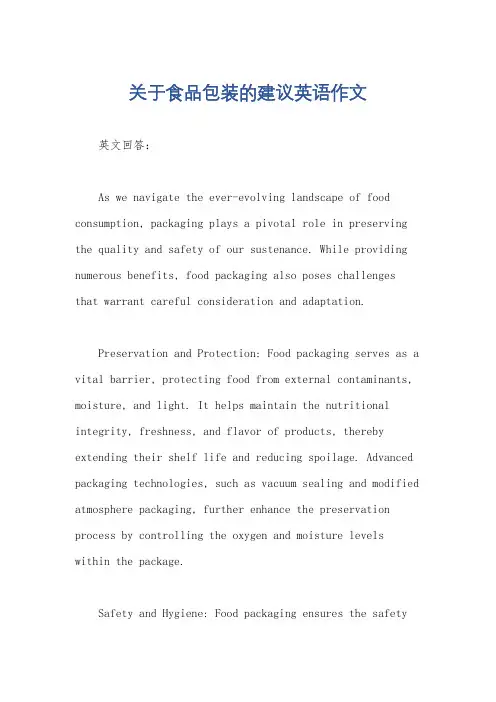
关于食品包装的建议英语作文英文回答:As we navigate the ever-evolving landscape of food consumption, packaging plays a pivotal role in preserving the quality and safety of our sustenance. While providing numerous benefits, food packaging also poses challengesthat warrant careful consideration and adaptation.Preservation and Protection: Food packaging serves as a vital barrier, protecting food from external contaminants, moisture, and light. It helps maintain the nutritional integrity, freshness, and flavor of products, thereby extending their shelf life and reducing spoilage. Advanced packaging technologies, such as vacuum sealing and modified atmosphere packaging, further enhance the preservation process by controlling the oxygen and moisture levelswithin the package.Safety and Hygiene: Food packaging ensures the safetyof food products by preventing contamination andmaintaining sanitary conditions. It acts as a safeguard against pathogens, bacteria, and other microorganisms that can cause foodborne illnesses. The use of sterile materials, such as plastics and glass, and rigorous hygiene practices during packaging contribute to the overall safety of our food supply.Convenience and Efficiency: Modern food packaging is designed for convenience and ease of use. Resealable pouches, easy-open lids, and microwave-safe containers make food preparation and storage more efficient. Portioncontrol packaging helps consumers manage their food intake and reduce waste. Additionally, packaging can provide valuable information about the product, its ingredients,and nutritional value, empowering consumers to makeinformed choices.Environmental Concerns: The environmental impact offood packaging is a critical consideration. Traditional packaging materials, such as plastics and aluminum, canhave detrimental effects on the environment if not properlydisposed of or recycled. As environmental awareness grows, sustainable packaging solutions are being developed and adopted. Biodegradable and compostable materials, as well as reusable or refillable containers, aim to minimize the ecological footprint of food packaging.Innovation and Future Trends: The food packaging industry is constantly evolving, with research and development focused on improving sustainability, functionality, and consumer experience. Novel materials, such as edible and biodegradable films, are being explored to reduce waste and enhance food preservation. Smart packaging technologies, equipped with sensors and indicators, can monitor food quality and track its origin, providing consumers with real-time information about their food.中文回答:食品包装的建议。
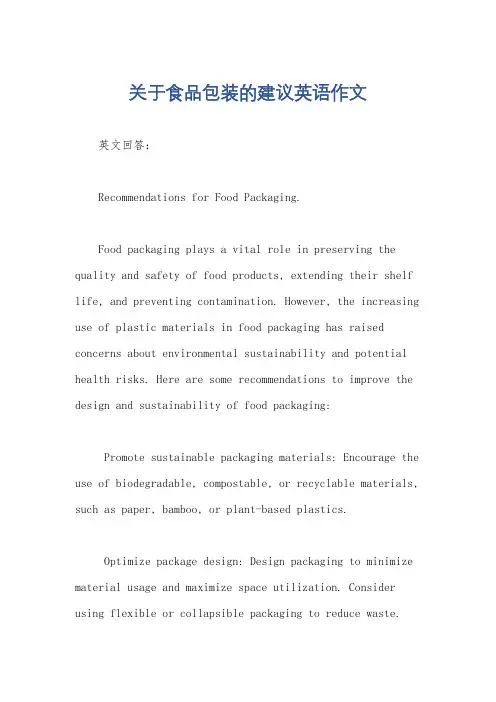
关于食品包装的建议英语作文英文回答:Recommendations for Food Packaging.Food packaging plays a vital role in preserving the quality and safety of food products, extending their shelf life, and preventing contamination. However, the increasing use of plastic materials in food packaging has raised concerns about environmental sustainability and potential health risks. Here are some recommendations to improve the design and sustainability of food packaging:Promote sustainable packaging materials: Encourage the use of biodegradable, compostable, or recyclable materials, such as paper, bamboo, or plant-based plastics.Optimize package design: Design packaging to minimize material usage and maximize space utilization. Consider using flexible or collapsible packaging to reduce waste.Provide clear labeling: Ensure packaging labels provide accurate information about the product, its ingredients, and any potential allergens. This helps consumers make informed choices and promotes transparency.Encourage consumer recycling: Make it easy for consumers to recycle packaging by providing clear instructions and access to recycling facilities. Implement deposit-return schemes to incentivize recycling.Promote reusable packaging: Explore the use of reusable containers, such as glass jars or reusable bags, especially for bulk purchases or frequently consumed items.Innovate in packaging technology: Invest in research and development to create new and innovative packaging solutions that reduce environmental impact and enhance food safety.Promote education and awareness: Educate consumers and stakeholders about the importance of sustainable foodpackaging and how their choices can contribute to a greener future.Enforce regulations and standards: Establish and enforce regulations to ensure food packaging meets safety, environmental, and labeling standards.中文回答:食品包装的建议。
绿色电商物流英语In the era of digital transformation, the concept ofgreen e-commerce logistics has emerged as a pivotal strategy for sustainable development. It focuses on reducing the environmental footprint of online shopping by optimizing packaging, transportation, and delivery processes.The integration of eco-friendly practices in logistics is not just a corporate responsibility but also a competitive advantage. Companies that adopt green logistics are often perceived as more socially responsible, which enhances their brand image and consumer loyalty.One of the key components of green e-commerce logisticsis the use of biodegradable packaging materials. These materials are designed to break down naturally, reducing the amount of waste that ends up in landfills and oceans.Another aspect is the optimization of delivery routes to minimize fuel consumption and emissions. By leveraging advanced algorithms and real-time data, logistics companies can plan more efficient routes, thereby reducing the carbon footprint of their operations.The adoption of electric or hybrid vehicles for delivery services is also a significant step towards greener logistics. These vehicles produce fewer emissions, contributing tocleaner air and a healthier environment.Moreover, promoting the use of public transportation or shared delivery services can further decrease the number of vehicles on the road, leading to less traffic congestion and lower emissions.Encouraging customers to choose green delivery options, such as consolidated shipments or eco-friendly packaging, can also play a crucial role in reducing the overall environmental impact of e-commerce.In conclusion, green e-commerce logistics is an essential component of a sustainable future. By implementing environmentally friendly practices, businesses can contribute to a healthier planet while also enhancing their market position.。
英语作文-快递服务行业的可持续发展与绿色标准The Sustainable Development and Green Standards of the Express Delivery Service Industry。
The express delivery service industry has experienced rapid growth in recent years, driven by the increasing demand for convenient and efficient delivery of goods. However, this growth has also brought about environmental challenges, such as increased carbon emissions, excessive packaging waste, and pollution from delivery vehicles. In order to address these challenges and ensure the sustainable development of the industry, it is crucial to establish and adhere to green standards.One of the key aspects of sustainable development in the express delivery service industry is the reduction of carbon emissions. This can be achieved through the adoption of eco-friendly delivery vehicles, such as electric or hybrid trucks and bicycles. By transitioning to these vehicles, delivery companies can significantly reduce their carbon footprint and contribute to the fight against climate change. In addition, optimizing delivery routes and schedules can also help minimize the emissions generated from transportation.Another important consideration for the sustainable development of the industry is the reduction of packaging waste. Many goods are over-packaged, leading to unnecessary waste that ends up in landfills. To address this issue, delivery companies should work with their clients to promote the use of minimal and recyclable packaging materials. Additionally, the industry can explore innovative packaging solutions, such as reusable containers and biodegradable packaging, to further minimize environmental impact.Furthermore, the industry should prioritize the use of renewable energy sources to power its operations. This can include the installation of solar panels and the purchase of renewable energy credits to offset the electricity consumption of delivery facilities. Bytransitioning to renewable energy, the industry can reduce its reliance on fossil fuels and contribute to the development of a more sustainable energy infrastructure.In addition to these measures, the industry should also invest in technology and infrastructure that supports sustainable practices. For example, the implementation of advanced tracking and logistics systems can help optimize delivery routes, reduce fuel consumption, and minimize the overall environmental impact of the industry's operations. Moreover, the development of eco-friendly packaging materials and the use of digital documentation can further streamline processes and reduce the industry's ecological footprint.It is important for the express delivery service industry to collaborate with government agencies, environmental organizations, and other stakeholders to establish and uphold green standards. By working together, the industry can develop and implement comprehensive sustainability policies that promote responsible environmental practices and ensure the long-term viability of the industry.In conclusion, the sustainable development of the express delivery service industry is essential for mitigating its environmental impact and ensuring a greener future. By reducing carbon emissions, minimizing packaging waste, transitioning to renewable energy, and embracing sustainable technology and practices, the industry can make significant strides towards achieving its green standards. It is imperative for all stakeholders to work together towards this common goal and prioritize the adoption of environmentally friendly policies and practices. Only through these collective efforts can the industry truly achieve sustainable development and contribute to a healthier planet for future generations.。
英语作文减少大量的垃圾Title: Strategies to Reduce a Significant Amount of Waste in English。
In today's world, the issue of waste management has become increasingly critical. With the rapid growth of population and industrialization, the accumulation of waste poses significant challenges to the environment and human health. Hence, it is imperative to implement effective strategies to minimize the production of waste. This essay explores various measures to reduce a substantial amount of waste.Firstly, promoting awareness and education is essential in addressing the issue of waste generation. Educating individuals from a young age about the importance of waste reduction, recycling, and responsible consumption caninstill lifelong habits that contribute to a cleaner environment. Schools, community organizations, and government agencies can collaborate to organize workshops,seminars, and campaigns to raise awareness about waste management practices.Secondly, implementing policies and regulations to encourage waste reduction is crucial. Governments can impose taxes on non-biodegradable materials, single-use plastics, and products with excessive packaging to discourage their usage. Furthermore, introducing incentives for companies that adopt eco-friendly practices, such as utilizing recyclable materials and reducing packaging waste, can stimulate sustainable production processes.Thirdly, investing in infrastructure for waste management and recycling facilities is paramount. Adequate infrastructure ensures proper collection, sorting, and disposal of waste, thereby minimizing environmental pollution. Governments should allocate funds for the development of recycling centers, composting facilities,and waste-to-energy plants to encourage the efficient utilization of resources and reduce landfill emissions.Additionally, fostering collaboration betweenstakeholders is essential in achieving effective waste reduction. Collaboration between government agencies, businesses, non-profit organizations, and communities can lead to the implementation of comprehensive waste management strategies. By working together, stakeholders can share resources, expertise, and best practices to optimize waste reduction efforts and maximize environmental benefits.Moreover, promoting the adoption of sustainablelifestyle choices is crucial in reducing waste generation. Encouraging individuals to embrace minimalism, reuse items, and purchase products with minimal packaging can significantly reduce household waste. Furthermore, advocating for the use of reusable alternatives such as cloth bags, stainless steel water bottles, and glass containers can help eliminate the reliance on disposable products.Furthermore, leveraging technology and innovation can revolutionize waste management practices. Advancements in waste sorting technologies, composting techniques, andrecycling processes can enhance the efficiency of waste management systems. Additionally, investing in research and development for biodegradable materials and alternative packaging solutions can facilitate the transition towards a circular economy.In conclusion, addressing the issue of waste generation requires a multifaceted approach that involves raising awareness, implementing policies, investing in infrastructure, fostering collaboration, promoting sustainable lifestyles, and embracing innovation. By adopting these strategies, we can collectively work towards reducing a significant amount of waste and preserving the planet for future generations.。
木制包装行业市场现状分析及未来三到五年发展趋势报告Analysis of Current Status and Future Development Trends of the Wooden Packaging IndustryWith the increasing awareness of environmental protection and sustainable development, wooden packaging has gradually become a popular choice for many industries. In recent years, the wooden packaging industry has developed rapidly, and its market scale has continued to expand. However, there are still some challenges and opportunities that need to be addressed.Current Status of the Wooden Packaging IndustryThe wooden packaging industry is mainly divided into three categories: solid wood packaging, plywood packaging, and fiberboard packaging. Among them, solid wood packaging has the highest market share due to its excellent performance in terms of strength, durability, and aesthetics.In terms of application, wooden packaging is widely usedin transportation, storage, and display of various products, such as food, beverages, cosmetics, and electronic products. With the growth of e-commerce and cross-border trade, the demand for wooden packaging has increased significantly.In addition, the wooden packaging industry is also affected by various factors, such as raw material prices, environmental regulations, and technological innovation. For example, the rising cost of timber and the increasing demand for sustainable forestry have put pressure on the industry. Moreover, the development of new materials and technologies, such as biodegradable plastics and 3D printing, may also affect the market share of wooden packaging in the future.Future Development Trends of the Wooden Packaging IndustryDespite the challenges, the wooden packaging industry still has great potential for development. Here are some of the key trends and opportunities in the next three to five years:1. Sustainable DevelopmentAs environmental protection becomes a top priority for many industries, the demand for sustainable and eco-friendly packaging solutions is increasing. Wooden packaging, as a renewable and biodegradable material, is expected to become a more popular choice for consumers and businesses.2. Innovation and CustomizationTo meet the diverse needs of different industries and products, wooden packaging manufacturers need to be more innovative and flexible in their design and production. Customization and personalization of wooden packaging can also create more value for customers and enhance the competitiveness of the industry.3. Digitalization and AutomationThe wooden packaging industry can also benefit from digitalization and automation technologies, such as artificial intelligence, robotics, and the Internet of Things. These technologies can improve production efficiency, reduce labor costs, and enhance product quality and traceability.4. Internationalization and IntegrationWith the increasing globalization of trade and investment, the wooden packaging industry needs to expand its international market and strengthen its cooperation and integration with other industries and regions. This can help to enhance the industry's competitiveness and create more opportunities for growth and innovation.ConclusionOverall, the wooden packaging industry is facing both challenges and opportunities in the current market environment. However, with the right strategies and actions, the industry can continue to grow and thrive in the next three to five years, and contribute to the sustainable development of the economy and society.木制包装行业市场现状分析及未来三到五年发展趋势报告随着环保和可持续发展意识的不断提高,木制包装逐渐成为许多行业的热门选择。
英语作文-快递服务行业的节能减排与绿色包装The parcel delivery industry plays a crucial role in modern society, facilitating the movement of goods and products across vast distances. However, this convenience often comes at a cost to the environment due to the emissions generated by delivery vehicles and the excessive use of packaging materials. In recent years, there has been a growing awareness of the need to reduce the environmental impact of the delivery sector through energy conservation, emission reduction, and the adoption of green packaging practices.One of the key strategies for reducing the environmental footprint of the parcel delivery industry is through the implementation of energy-saving measures. This can be achieved through various means, including the use of more fuel-efficient vehicles, optimization of delivery routes to minimize mileage, and the adoption of alternative energy sources such as electric or hybrid vehicles. By reducing the amount of energy consumed in the delivery process, companies can significantly decrease their carbon emissions and contribute to a cleaner, more sustainable environment.In addition to energy conservation, another important aspect of sustainable delivery practices is the reduction of packaging waste through the use of green packaging materials. Traditional packaging materials such as plastic bubble wrap and Styrofoam peanuts are not only non-biodegradable but also contribute to pollution and landfill accumulation. To address this issue, many delivery companies are now turning to eco-friendly packaging alternatives such as recycled cardboard, biodegradable plastics, and compostable materials.Furthermore, the concept of "right-sizing" packaging has gained traction in the industry as a way to minimize waste and optimize space utilization. By using packaging that is appropriately sized for the item being shipped, companies can reduce the amount of excess packaging material used and maximize the efficiency of delivery vehicles. Thisnot only helps to reduce environmental impact but also lowers shipping costs for both businesses and consumers.Moreover, advancements in technology have enabled the development of innovative solutions to further enhance the sustainability of the delivery industry. For example, the use of smart logistics systems can help companies optimize delivery routes in real-time, reducing fuel consumption and emissions. Similarly, the introduction of reusable packaging options and packaging deposit schemes can help to minimize single-use packaging waste and promote a circular economy model.In conclusion, the parcel delivery industry has a significant opportunity to contribute to environmental sustainability by implementing energy-saving measures and adopting green packaging practices. By prioritizing efficiency, waste reduction, and innovation, companies can reduce their carbon footprint and minimize environmental harm while continuing to meet the growing demand for delivery services. Through collective efforts and collaboration across the supply chain, the industry can pave the way towards a more sustainable future for parcel delivery.。
熟悉茶产业发展趋势英文The Emerging Trends in the Tea IndustryIntroductionThe tea industry has witnessed significant growth and development over the years. From being a traditional beverage in several cultures to becoming a global sensation, tea has become a staple in many households. With the increasing popularity and demand for tea, there has been a remarkable expansion in the tea industry and its associated products. This article aims to analyze the emerging trends in the tea industry, including changes in consumption patterns, production methods, packaging innovations, health benefits, and sustainability practices.Changing Consumption PatternsThe way tea is consumed has evolved to suit the modern lifestyle. Traditionally, tea was consumed mainly as a hot beverage, but now there is a significant shift towards iced tea and ready-to-drink tea. These varieties are particularly popular among the younger generation, who are seeking convenience and new flavors. Fruit-infused iced teas and sparkling teas are gaining momentum, with companies introducing innovative flavors to cater to diverse consumer preferences.Green tea, known for its health benefits, has seen a surge in consumption in recent years. With increasing awareness about the benefits of green tea, consumers are incorporating it into their daily routine. Matcha, a type of powdered green tea, has also gained popularity due to its high concentration of antioxidants and versatility in culinary applications.Specialty tea is another emerging trend in the tea industry. Consumers are becoming more knowledgeable and discerning about tea varieties, flavors, and origins. They are seeking unique and high-quality teas, often purchasing directly from tea estates or specialty tea shops. This trend has driven the growth of specialty tea retailers and online platforms for tea enthusiasts.Production Methods and TechnologyThe tea industry has witnessed advancements in production methods and technology to ensure efficiency, quality, and sustainability. Mechanization and automation in tea production have reduced labor costs, improved productivity, and enhanced the quality of tea. Tea harvesting machines, automated processing systems, and precision control technology have played a significant role in streamlining the production process.In addition, the development of new tea cultivars has resulted in improved yield, resistance to pests and diseases, and enhanced flavor profiles. The use of biotechnology and genetic engineering in tea cultivation is a promising area that has the potential to revolutionize the industry. Scientists are working on developing genetically modified tea plants that can withstand adverse climatic conditions and produce teas with unique flavors and antioxidant properties.Packaging InnovationsPackaging plays a crucial role in attracting consumers and preserving the quality of tea. Innovative packaging solutions have emerged to address consumer demands for convenience,sustainability, and freshness. Single-serve tea bags, loose-leaf tea sachets, and pyramid-shaped tea bags have gained popularity as they offer convenience and quick brewing. These packaging formats also allow for better extraction of flavors and aromas, enhancing the overall tea-drinking experience.Another packaging trend is the use of eco-friendly materials and sustainable packaging practices. As consumers become more conscious of their environmental impact, tea companies are adopting biodegradable and compostable packaging materials, such as plant-based films and paper-based sachets. Additionally, packaging designs are becoming more visually appealing, incorporating unique shapes, colors, and patterns to create a memorable and attractive product.Health Benefits and Functional TeasTea is widely known for its health benefits, and this aspect has become a significant driver of consumer choices. Various tea blends are marketed for their specific health benefits, such as immune support, digestion, relaxation, and weight management. Herbal teas, infused with natural ingredients like chamomile, ginger, and peppermint, have gained popularity for their soothing and therapeutic properties.Functional teas, enriched with vitamins, minerals, and other bioactive compounds, are gaining traction as consumers seek beverages that offer more than just hydration. Green tea, white tea, and herbal teas are often combined with ingredients like turmeric, elderberry, and echinacea to promote immune health and overall well-being. Companies are investing in research and developmentto create innovative blends that cater to specific health concerns of consumers.Sustainability and Ethical PracticesThe tea industry has recognized the need for sustainable and ethical practices to ensure the long-term viability of tea production. Sustainable farming practices, such as organic and biodynamic cultivation, are gaining prominence as consumers prioritize products that are free from chemical pesticides and fertilizers. Fair trade certifications and direct trade relationships between tea producers and buyers are becoming more common, ensuring fair wages and working conditions for tea workers.Efforts are also being made to reduce the carbon footprint of tea production and distribution. Tea companies are implementing energy-efficient technologies, promoting waste reduction, and utilizing renewable energy sources. Some companies have even introduced initiatives to offset their carbon emissions by investing in reforestation projects or supporting renewable energy development.The Role of E-commerce and Social MediaThe advent of e-commerce and social media platforms has transformed the tea industry by providing new marketing and distribution channels. Online platforms allow consumers to explore a wide range of tea varieties, purchase directly from producers, and access information about the teas' origins and quality. Tea subscription services have also gained popularity, offering curated selections of teas delivered to consumers' doorsteps.Social media has become a powerful tool for tea companies to engage with consumers, promote their products, and share tea-related content. Influencer marketing, where popular bloggers and YouTubers review and endorse tea products, has become a popular strategy to reach a wider audience. Tea companies are also leveraging social media platforms to educate consumers about tea culture, brewing techniques, and the health benefits of tea. ConclusionThe tea industry is experiencing dynamic changes driven by evolving consumer preferences, technological advancements, and sustainability concerns. The emergence of new consumption patterns, production methods, packaging innovations, health-focused teas, and sustainable practices are shaping the future of the tea industry. As the global demand for tea continues to grow, it is essential for tea producers, retailers, and consumers to adapt to these trends and embrace the opportunities they present.。
Packaging and Sustainable Development
. In the 1970s, the packaging industry faced a number of challenges. The two oil crises of 1973 and 1978 produced a situation in which energy conservation became a top priority. At the same time, goods manufacturers and retailers were demanding ever lighter packaging that would cut the amount of resources used in manufacture and the energy used in transportation.
Environmental groups were using packaging in their campaigns as a symbol of the “throwaway” society. By t he affluent 1980s, the emphasis was shifting. What had been a serious energy problem had been replaced by what was seen as a solid waste disposal problem. People were less worried about the energy being used and more concerned about what happened to the waste. Environmental groups argued that packaging should be reduced to help solve the “waste problem”. Companies are also faced with the problem that consumers often say that they think packaging is a waste of resources.
For economic reasons, companies design packaging to use just enough, and no more, material than is needed to ensure that goods survive the distribution chain and are delivered to consumers in good condition. In developing countries, up to 50% of food is wasted on the journey from farm to shop. In Western Europe less than 3% goes to waste. Packaging is a significant fraction—between 20% and 25% by weight—of musical al solid waste, which is largely household waste. What the consumer does not see is that household dustbin waste makes up less than 20% of the total solid waste from all sources sent to landfill in a typical European country. Landfill is dominated by industrial, demolition and construction waste. Household packaging accounts for less than 5% by weight or volume.
Rather than respond to these issues individually, companies in the packaging sector decided to set up a joint body known as the Industry Council for Packaging and the Environment (INCPEN) to carry out research into the environmental and social effects of packaging. INCPEN produced the first detailed estimates of the amount of packaging that enters the waste stream and its relationship to total waste generation. It has commissioned studies into the energy requirements of packaging production and packaging distribution systems, and it has carried out surveys of litter. INCPEN commissioned an independent study called “Packaging in a Market Economy”, which examined he functional, environmental, social and economic considerations involved in packaging assessment, including case studies on the packaging for fish, computer monitors, liquid detergents and luxury cosmetics. More recently, it has published a report on the environmental impact of packaging in the UK food supply system, investigating the resource requirements of food packaging against those of food production and distribution. The findings from this research have been used to promote good packaging practice, and to inform legislators, consumers and interest groups about the role of packaging. . At the same time, there are compensating developments that will tend towards reduced packaging. For example, many companies, especially in the retail sector, are increasingly designing all the packaging needed to protect goods (the packaging immediately containing the goods, the secondary or grouping, packaging and the packaging used to transport the grouped packs) as complete systems. This makes more effective us of resources.
. Today, INCPEN's major task is to develop effective working partnerships with government regulators, to ensure that policy on packaging aligns more closely with the major needs of sustainable development, rather than simply seeking to reduce the quantities of packaging
materials used. Current restrictive laws on packaging need to be replaced with policies that enable companies to develop packaging systems that will help make more efficient use of resources in getting goods from point of production to consumption.。